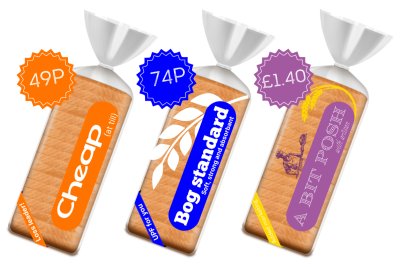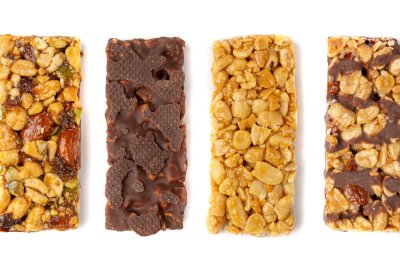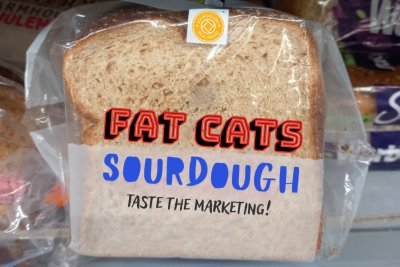Supermarket loaves: why the massive markup?
How do the multiples justify charging 200% more for a ‘premium’ loaf?

While it's possible to make Real Bread at home for pence, people sometimes ask us why small, independent bakeries have to charge what they do. I’ll come back to that later, as a more interesting question is: how do supermarkets justify massive differences between their ‘value’ and apparently near-identical ‘premium’ loaves?
Same stuff different rate?
A number of the multiples operate a three-tier pricing system. For example, in April 2025, The Co-op was charging the equivalent of 72p* for its ‘Honest Value White Bread’, £1.35 for its 800g ‘Farmhouse White’ and £2.10 for the ‘Irresistible White Sliced Farmhouse Loaf’.
The UK’s largest supermarket chain, Tesco, was choosing to charge an even bigger difference. At the time of writing, the company's 800g ‘Finest’ sliced white loaf (£1.50) is more than three times the price of the one in its H.W. Nevill's range (49p) - a 206% difference.
What was the retailer's justification for this? Let’s compare what Tesco customers got for dough:
H.W. Nevill's Medium Sliced White
Wheat Flour [Wheat Flour, Calcium Carbonate, Iron, Niacin, Thiamin], Water, Yeast, Salt, Preservative (Calcium Propionate), Emulsifiers (Mono- and Di-Acetyl Tartaric Acid Esters of Mono- and Di-Glycerides of Fatty Acids), Spirit Vinegar, Rapeseed Oil, Flour Treatment Agent (Ascorbic Acid).
Tesco Medium Sliced White
Wheat Flour [Wheat Flour, Calcium Carbonate, Iron, Niacin, Thiamin], Water, Yeast, Salt, Preservative (Calcium Propionate), Soya Flour, Spirit Vinegar, Emulsifier (Mono- and Diacetyl Tartaric Acid Esters of Mono- and Diglycerides of Fatty Acids), Rapeseed Oil, Flour Treatment Agent (Ascorbic Acid).
Tesco Finest White
Wheat Flour [Wheat Flour, Calcium Carbonate, Iron, Niacin, Thiamin], Water, Yeast, Salt, Wheat Bran, Preservative (Calcium Propionate), Sourdough (Wheat)**, Emulsifiers (Mono- and Diglycerides of Fatty Acids, Mono- and Diacetyl Tartaric Acid Esters of Mono- and Diglycerides of Fatty Acids), Spirit Vinegar, Rapeseed Oil, Flour Treatment Agent (Ascorbic Acid).
Even if the flour was different, that would account for mere pence, so I’ll leave you to play spot the difference, while I move onto methods of manufacture.
It stands to reason that there are price differences between products that are hand-crafted in small batches by skilled artisans locally, and ones that are mass-produced on fully-automated production lines in remote factories. ou wouldn't expect to pay the same for a piece of furniture from a cabinetmaker as you would for something from IKEA. Similarly, a like-for-like comparison can't be made between Real Bread from a small bakery and a factory loaf.
All of these loaves are manufactured at a similar scale by the Chorleywood Process, though.
*The UK standard large loaf size is 800g This loaf is 720g, for which The Co-op charges 65p. Shrinkflation in action?
**The ‘sourdough’ listed here doesn’t necessarily mean the loaf was made by artisan bakers using a long, slow fermentation process. It’s likely to indicate powdered, deactivated starter, added as a flavour enhancer. As ingredients are listed in weight order, and the loaf is 0.91% salt, there’s only a tiny amount of it.
Skewing the SKUs?
Perhaps artificial price skewing is the answer. At one end of the spectrum, are retailers pricing ‘value’ loaves below the cost of production as loss leaders? This tactic can be used to influence people’s perception of a supermarket’s general prices. Take a profit hit on the prices of a bunch of ‘known value items’ in the hope that shoppers will perceive your chain to be cheaper overall than the others. The aim is to attract shoppers away from the competition, to then more than make up the shortfall across the rest of their shopping. One supermarket price war race to the bottom reached a nadir in 1999 when Tesco slashed the price of a loaf to just 7p, which got even the Feds* grumbling.
So to the other end of the spectrum. Assuming a ‘standard’ loaf is priced to cover its costs, plus a reasonable profit margin, then is the huge markup on a ‘premium’ loaf all going towards directors' bonuses and shareholder dividends?
*The Federation of Bakers, a trade body that represents many of the UK’s industrial dough fabricators. The FoB has argued that below cost selling of factory loaves is detrimental to small retailers – perhaps the only thing we agree with them on. Might loss of their members’ income, and public perception of the white sliced loaf being an almost worthless item, have been issues for them as well?
DIY vs. delicious dough dealers
Returning to the question at the start of this post, it’s currently possible to buy a 1.5kg bag of bread flour for as little as about £1.10. This will make three large loaves, so why do small, indie artisan bakeries have to charge around £4-6 for one?*
When working out how much it costs you to make bread at home, how much do you factor in as a contribution towards:
- Salaries, National Insurance, sick pay, parental leave, holiday pay and other staffing costs.
- Energy to power the oven, heating, lighting etc.
- Rent.
- Water and sewage.
- Recycling and refuse collection
- Business rates.
- Business and public liability insurance.
- Equipment purchase, maintenance and depreciation.
- Vehicle purchase, maintenance, fuel and depreciation.
- Packaging.
- Marketing.
- Payment system.
- Accounting and other professional services.
A small, independent bakery business has to account for many of these (and other) costs in order to remain financially sustainable and keep serving its local community.
*For the issue of bridging the gap between this price and what people on the tightest budgets can realistically afford, see Real Bread For All.
Whataboutery
‘Aha’ I hear someone say / type, ‘a supermarket has to pay for those, too!’
Indeed, but the economies of scale are totally different. A factory’s costs are spread across hundreds of thousands of loaves a day (compared to a small bakery’s hundreds or thousands), while bulk buying savings also work in the favour of larger manufacturers.
That’s all before you consider the financial and social benefit to a local community and economy that a small indie business provides by (to use one of my favourite lines) supporting more jobs per loaf and helping to keep a high street alive.
…not to mention the value (and values) represented by delicious, nutritious, non-UPF, additive-free, Real Bread, expertly-crafted by a skilled, genuine artisan baker from high quality ingredients, using a long, slow fermentation process.
On the flipside, hidden and displaced costs (ill health and resulting burden on the NHS that we taxpayers pay for; the environment; local economies; workers’ welfare, rights and pay; animal welfare etc.) that might lurk behind ‘cheap’ food are fodder for a whole series of blog posts…
Note: every (micro)bakery is different, so the costs and other factors outlined in this last section will vary between each of them.
Enough of the educated guesswork
On 29 April 2025, I attempted to contact retailers by email, asking them to explain the large price differences between their apparently near-identical products.
- Aldi: Unable to find email address. Query submitted via online form.
- Asda: Unable to find email address. Query submitted via online media contact form.
- The Co-op: Unable to find email address. Query submitted via online form.
- Iceland: Unable to find email address. Query submitted via online form.
- Lidl: Unable to find email address. Query submitted via online form.
- M&S: Emailed query.
- Morrisons: Unable to find email address. Query submitted via online form.
- Sainsbury’s: Unable to find email address. Query submitted via online chat.
- Tesco: Emailed query. Auto-response said email address is no longer in use. Unable to find online contact form. Query sent to media contact email address.
- Waitrose: Emailed query.
Published Wednesday 30 April 2025
Real Bread Campaign: Finding and sharing ways to make bread better for us, our communities and planet.







